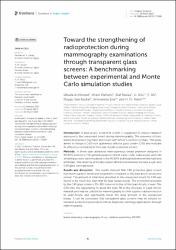| dc.contributor.author | Almisned, Ghada | |
| dc.contributor.author | Elshami, Wiam | |
| dc.contributor.author | Rabaa, Elaf | |
| dc.contributor.author | Kılıç, Gökhan | |
| dc.contributor.author | Ilık, Erkan | |
| dc.contributor.author | Şen Baykal, Duygu | |
| dc.contributor.author | Ene, Antoaneta | |
| dc.contributor.author | Tekin, Hüseyin Ozan | |
| dc.date.accessioned | 2023-10-20T08:09:10Z | |
| dc.date.available | 2023-10-20T08:09:10Z | |
| dc.date.issued | 2023 | en_US |
| dc.identifier.citation | ALMisned, G; Elshami, W; Rabaa, E; Kılıç, G; Ilık, E; Şen Baykal, D; Ene, A; Tekin, HO. Toward the strengthening of radioprotection during mammography examinations through transparent glass screens: a benchmarking between experimental and Monte Carlo simulation studies. Frontiers in Public Health (2023), c.11. | en_US |
| dc.identifier.issn | 2296-2565 | |
| dc.identifier.uri | https://www.frontiersin.org/articles/10.3389/fpubh.2023.1171209/full | |
| dc.identifier.uri | https://doi.org/10.3389/fpubh.2023.1171209 | |
| dc.identifier.uri | https://hdl.handle.net/20.500.12780/638 | |
| dc.description.abstract | IntroductionA lead-acrylic protective screen is suggested to reduce radiation exposure to the unexposed breast during mammography. The presence of toxic lead in its structure may harm the tissues with which it comes in contact. This study aimed to design a CdO-rich quaternary tellurite glass screen (C40) and evaluate its efficiency compared to the Lead-Acrylic protective screen. MethodsA three-layer advanced heterogeneous breast phantom designed in MCNPX (version 2.7.0) general-purpose Monte Carlo code. Lead acrylic and C40 shielding screens were modeled in the MCNPX and installed between the right and left breast. The reliability of the absorption differences between the lead acrylic and C40 glass were assessed. Results and discussionThe results showed that C40 protective glass screen has much superior protection properties compared to the lead acrylic protective screen. The amount of total dose absorbed in the unexposed breast for C40 was found to be much less than that for lead-based acrylic. The protection provided by the C40 glass screen is 35-38% superior to that of the Lead-Acrylic screen. The C40 offer the opportunity to avoid the toxic Pb in the structure of Lead-Acrylic material and may be utilized for mammography to offer superior radioprotection to Lead-Acrylic and significantly lower the dose amount in the unexposed breast. It can be concluded that transparent glass screens may be utilized for radiation protection purposes in critical diagnostic radiology applications through mammography. | en_US |
| dc.language.iso | eng | en_US |
| dc.publisher | Frontiers Media | en_US |
| dc.relation.isversionof | 10.3389/fpubh.2023.1171209 | en_US |
| dc.rights | info:eu-repo/semantics/openAccess | en_US |
| dc.subject | Breast dosimetry | en_US |
| dc.subject | Mammography | en_US |
| dc.subject | X-ray | en_US |
| dc.subject | Radiation protection | en_US |
| dc.subject | MCNPX | en_US |
| dc.title | Toward the strengthening of radioprotection during mammography examinations through transparent glass screens: a benchmarking between experimental and Monte Carlo simulation studies | en_US |
| dc.type | article | en_US |
| dc.contributor.department | İstanbul Kent Üniversitesi, Fakülteler, Sağlık Bilimleri Fakültesi, Fizyoterapi ve Rehabilitasyon Bölümü | en_US |
| dc.contributor.authorID | https://orcid.org/0000-0001-9833-9392 | en_US |
| dc.contributor.institutionauthor | Şen Baykal, Duygu | |
| dc.identifier.volume | 11 | en_US |
| dc.relation.journal | Frontiers in Public Health | en_US |
| dc.relation.publicationcategory | Makale - Uluslararası Hakemli Dergi - Kurum Öğretim Elemanı | en_US |


















